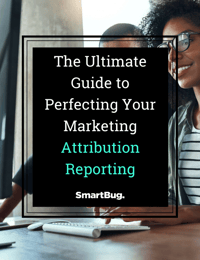
Marketing Attribution 101: Your Guide to Getting Started
October 31, 2022
By Kristen Deyo
On a recent episode of the SmartBug on Tap podcast, we discussed all things marketing attribution. And it should come as no surprise why: Marketing leaders are increasingly being asked about ROI. You might be getting questions like:
- “What’s the ROI on this campaign?”
- “Where do those leads come from?”
- “How do you know if your marketing spend is generating real value?”
As a marketing leader, how can you best manage expectations internally, answer questions about attribution confidently, and ensure your efforts are contributing to the bottom line? Look no further; here are some highlights from the episode.
The Marketing Attribution Saga: Did It Really Come from Marketing?
We’ve all been there as marketers. We see a campaign we’ve executed is showing a closed deal, and a closed deal means revenue. We’re ready to shout from the rooftops and let the organization know, and just when we do, tribal knowledge comes knocking and we hear this: “Wait, I think that lead was already in conversation with us before this campaign, so I’m not sure we can attribute this to marketing.” In that moment, your heart sinks.
But this reveals one incredible aspect of marketing attribution that we need to understand: touchpoints. The buyer’s journey is anything but linear, and there is often a series of activities/behaviors—touchpoints—that result in someone going from a lead to a customer. As marketers, our job is to understand our influence in that buyer’s journey and what role our campaigns play in the conversion event or closing of that lead.
Marketing Attribution: Lead Source vs. Conversion Event
If you’re new to attribution reporting, it’s important to first understand some key definitions that will help ensure you can properly articulate when and how your marketing efforts are impacting conversions and sales. First, are you tracking lead source and conversion events?
Lead source: Where the lead first discovered who you are
Conversion event: Where you discovered who that lead was—or, more specifically, how you gained information on that lead record
There are a couple of examples that can help put this into context. Let's say that someone sees your ad on LinkedIn about a helpful ROI calculator. The lead source might be LinkedIn paid social (or just paid social if you're bucketing things), and then the conversion event, assuming that they downloaded that ROI calculator or filled out a form to get it, would be content download or the ROI calculator. In summary, your lead source is “paid media,” and your conversion event is “content download.”
Another example might be that someone searches for a keyword on Google—say “inbound marketing”—and they come across an agency like SmartBug that offers inbound marketing services. If and when they fill out a form to speak with sales, the lead source is organic, and then the conversion event is the contact us form. Lead source is “organic,” and conversion event is “contact us.”
Sometimes lead source and conversion events can be the same; other times they are not. Keeping both lead source and conversion events in mind helps set a baseline to help you get started with attribution reporting.
Taking Marketing Attribution Deeper
The next way to really level up your attribution reporting is to track one level deeper. We suggest making “lead source” a concise list with only a few options. Making people select from a small number of general options will make your reports really clean and easy to build off of. But don’t worry—you can have lead source detail as a kind of open text field that can be filled out for more detail.
At SmartBug, our marketing team has lead source and lead source detail fields automatically being filled out for everything that's considered an online conversion. That way, we have fewer blank fields and less unknown data coming into our CRM.
For example, anytime someone fills out a form for a content download, that conversion event is tracked as “content download.” Meanwhile, the original source data for the lead source is tracked to lead source, so if they came from organic or paid social, that information is filled in automatically. And then the detail is where we track that conversion of that detail so we know what type of content they downloaded.
Pro tip: Bring your lead source information over to a deal record. If you’re using a tool like HubSpot, you can easily copy it to the deal record using an automated workflow.
Marketing Attribution Models to Consider
There are a lot of articles that offer deep dives on attribution models. But here is a quick snapshot of the types of attribution models you can begin to apply to understand how your marketing efforts are impacting the bottom line. Here are revenue attribution models via HubSpot:
First interaction: This model gives all credit to the first interaction that led to a closed won deal.
Last interaction: This model gives all credit to the last interaction that led to a closed won deal.
Linear: This model looks at all interactions that led to a closed won deal. Then gives equal credit to each interaction.
U-shaped: This model gives 40 percent of credit to the first interaction and 40 percent to the interaction that created a contact. Then it distributes the remaining 20 percent evenly across all interactions between the first interaction and contact creation.
W-shaped: This model gives 30 percent of credit to the first interaction, 30 percent to the interaction that created the contact, and 30 percent to the last interaction that created the deal. Then it distributes the remaining 10 percent evenly across all interactions between first interaction and deal creation.
Full-path: This model gives 22.5 percent of credit to the first interaction, 22.5 percent to the interaction that created the contact, 22.5 percent to the last interaction that created the deal, and 22.5 percent to the interaction that closed the deal. Then it distributes the remaining 10 percent evenly across all other interactions.
Time-decay: This model gives the most credit to the most recent interactions. The credit for interactions decays the longer it takes for a deal to become closed-won.
When it comes to marketing attribution models, there is no one-size-fits-all approach. How you choose which models to use depends on your marketing goals and the supported analysis that’s expected of your team. If this is an area where you want to dig further, here’s how marketers can prove ROI with marketing attribution.
Marketing Attribution: Next Steps
If you're not sure how ready you are to set up with marketing attribution, you should check out our marketing attribution readiness assessment. The assessment is essentially a quick quiz that really helps you identify what pieces you might be missing or what you need in order to implement and get up and running with attribution on your own. We hope you find it useful.
You can also listen to the full podcast episode here to learn more. Enjoy!
About SmartBug on Tap
SmartBug on Tap delivers weekly conversations and thought leadership from SmartBug Media on demand generation, marketing automation, brand loyalty, and digital strategy. If you’re looking for expert, game-changing thoughts on digital marketing, your search is over.
Each episode will feature topics such as lead generation, account engagement, brand loyalty, inbound marketing, sales enablement, PR, demand generation, marketing automation, paid media, web design and development, sales enablement, revenue growth, digital strategy, ROI, and more.
About the author
Kristen Deyo was formerly a Director of Marketing Strategy at SmartBug based in Kingston, Ontario, Canada. She has 8+ years experience developing strategies for primarily B2B SaaS/technology companies and hyper-growth startups. She holds degrees from Queen's University (Cha'Gheill!) and the St. Lawrence School of Business. When not digitally plugged in, you can find her enjoying a good happy hour or planning her next adventure. Read more articles by Kristen Deyo.






